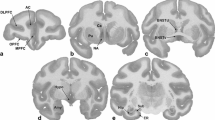Abstract
Cocaine and several other local anesthetics were tested for their ability to induce rotational behavior in rats with unilateral 6-hydroxydopamine lesions of substantia nigra. Acute administration of bupivacaine, chloroprocaine, etidocaine, lidocaine, mepivacaine, procaine or tetracaine failed to induce active rotation in this sensitive assay of dopamine agonist activity. On the other hand, cocaine or dimethocaine treatment induced active rotation directed ipsilaterally to the lesioned side, indicating indirect dopamine agonist activity. Repeated administration of cocaine or dimethocaine at 1-week intervals resulted in increased rotational response (i.e., sensitization) while there was no suggestion of sensitization or induction of rotational behavior after weekly repeated administration of procaine or tetracaine. Daily administration of mepivacaine, procaine or tetracaine for 5 days also failed to induce rotation. Dimethocaine thus was found similar to cocaine and different from the other local anesthetics tested both in terms of frank stimulant activity and development of sensitization upon repeated administration.
Similar content being viewed by others
References
Clarke RL, Daum AJ, Gambino SJ, Aceto MD, Pearl J, Levitt M, Cumiskey WR, Bogado EF (1973) Compounds affecting the central nervous system. 4. 3B-phenyltropane-2-carboxylic esters and analogs. J Med Chem 16:1260–1267
de la Garza R, Johanson CE (1983) The discriminative stimulus properties of cocaine in the rhesus monkey. Pharmacol Biochem Behav 19:145–148
Fischman MW, Schuster CR, Rijfer S (1983) A comparison of the subjective and cardiovascular effects of cocaine and procaine in humans. Pharmacol Biochem Behav 18:711–716
Ford RD, Balster RL (1977) Reinforcing properties of intravenous procaine in rhesus monkeys. Pharmacol Biochem Behav 6:289–296
Hammerbeck DM, Mitchell CL (1977) The reinforcing properties of procaine andd-amphetamine compared in rhesus monkeys. J Pharmacol Exp Ther 204:558–569
Hefti F, Melamed E, Sahakian BJ, Wurtman RJ (1980) Partial lesions of the dopaminergic nigrostriatal system in rat brain: biochemical characterization. Brain Res 195:123–137
Jarbe TUC (1984) Discriminative stimulus properties of cocaine: effects of apomorphine, haloperidol, procaine and other drugs. Neuropharmacology 23:899–907
Johanson CE (1980) The reinforcing properties of procaine, chloroprocaine and proparacaine in rhesus monkeys. Psychopharmacology 67:189–194
Lin-Chu G, Robinson TE, Becker JB (1985) Sensitization of rotational behavior produced by a single exposure to cocaine. Pharmacol Biochem Behav 22:901–903
McKenna ML, Ho BT (1980) The role of dopamine in the discriminative stimulus properties of cocaine. Neuropharmacology 19:297–303
Reith MEA, Meisler BE, Lajtha A (1985) Locomotor effects of cocaine, cocaine congeners, and local anesthetics in mice. Pharmacol Biochem Behav 23:831–836
Ritz MC, Lamb RJ, Goldberg SR, Kuhar MJ (1987) Cocaine receptors on dopamine transporters are related to self-administration of cocaine. Science 237:1219–1223
Ritz MC, Jamb RJ, Goldberg SR, Kuhar MJ (1988) Cocaine self-administration appears to be mediated by dopamine uptake inhibition. Prog Neuropsychopharmacol Biol Psychiatry 12:233–239
Scheel-Kruger J, Braestrup C, Nielsen M, Golembiowska K, Mogilnicka E (1977) Cocaine: discussion on the role of dopamine in the biochemical mechanism of action. In: Ellinwood EH, Jr, Kilbey MM (eds) Cocaine and other stimulants. Plenum Press, New York, pp 373–407
Silverman PB, Ho BT (1981) Persistent behavioral effect of apomorphine in 6-hydroxydopamine-lesioned rats. Nature 94:475–477
Silverman PB, Schultz KA (1989) Comparison of cocaine and procaine discriminative stimuli. Drug Dev Res 16:427–433
Ungerstedt U (1971) Postsynaptic supersensitivity after 6-hydroxydopamine induced degeneration of nigrostriatal dopamine system. Acta Physiol Scand [Suppl] 367:69–93
Wise RA (1984) Neural mechanisms of reinforcing actions of cocaine. In: Grabowski J (ed) Cocaine: pharmacology, effects, and treatment of abuse. NIDA Res Monogr, vol 50
Woolverton WL, Balster RL (1982) Behavioral pharmacology of local anesthetics: reinforcing and discriminative stimulus effects. Pharmacol Biochem Behav 16:491–500
Author information
Authors and Affiliations
Rights and permissions
About this article
Cite this article
Silverman, P.B. Cocaine and local anesthetics: Stimulant activity in rats with nigral lesions. Psychopharmacology 102, 269–272 (1990). https://doi.org/10.1007/BF02245932
Received:
Revised:
Issue Date:
DOI: https://doi.org/10.1007/BF02245932




